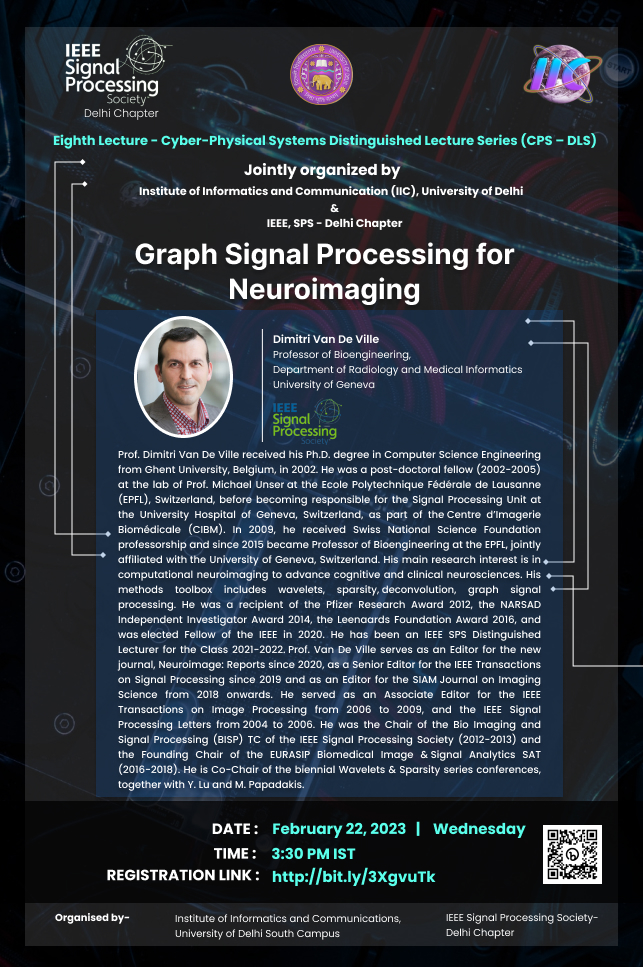The Institute of Informatics and Communication (IIC), University of Delhi, jointly with the IEEE Signal Processing Society-Delhi chapter, has started a Cyber Physical Systems Distinguished Lecture Series (CPS – DLS) beginning March 2022. IEEE Delhi chapter and IIC have been very active in organizing webinars with the help of international experts of diverse disciplines.
The eighth lecture of this series is scheduled for February 22, 2023 and will be delivered by Dimitri Van De Ville, Professor of Bioengineering, Department of Radiology and Medical Informatics, University of Geneva.

Prof Dimitri Van De Ville would be talking about how the emerging framework of graph signal processing can be tailored to neuroimaging by considering a brain graph (i.e., the structural connectome determined by diffusion-weighted MRI and tractography) and graph signals (i.e., the spatial activity patterns obtained by fMRI). The latter are decomposed onto graph harmonic bases defined through the eigen decomposition of the graph Laplacian. Spectral filtering operations are then designed to separate brain activity into its structurally aligned and liberal parts, respectively, which allows to quantify how strongly function is shaped by the underlying structure. The structure-function strength throughout the brain uncovers a behaviorally-relevant spatial gradient from uni to transmodal regions, and is also informative to decode task conditions or identify individuals.
Also, the lecture would discuss about how state-of-the-art neuroimaging such as magnetic resonance imaging (MRI) provides unprecedented opportunities to non-invasively measure human brain structure (anatomy) and function (physiology). Exploiting the rich spatiotemporal structure of these data to gain insights into brain function in health and disorder, necessitates new signal processing and modeling approaches, instilled by domain knowledge from neuroscience and instrumentation.
Prof Dimitri Van De Ville would be talking about how the emerging framework of graph signal processing can be tailored to neuroimaging by considering a brain graph (i.e., the structural connectome determined by diffusion-weighted MRI and tractography) and graph signals (i.e., the spatial activity patterns obtained by fMRI). The latter are decomposed onto graph harmonic bases defined through the eigen decomposition of the graph Laplacian. Spectral filtering operations are then designed to separate brain activity into its structurally aligned and liberal parts, respectively, which allows to quantify how strongly function is shaped by the underlying structure. The structure-function strength throughout the brain uncovers a behaviorally-relevant spatial gradient from uni to transmodal regions, and is also informative to decode task conditions or identify individuals.
Also, the lecture would discuss about how state-of-the-art neuroimaging such as magnetic resonance imaging (MRI) provides unprecedented opportunities to non-invasively measure human brain structure (anatomy) and function (physiology). Exploiting the rich spatiotemporal structure of these data to gain insights into brain function in health and disorder, necessitates new signal processing and modeling approaches, instilled by domain knowledge from neuroscience and instrumentation.
Kindly make the best use of this event to enhance your knowledge on this subject.